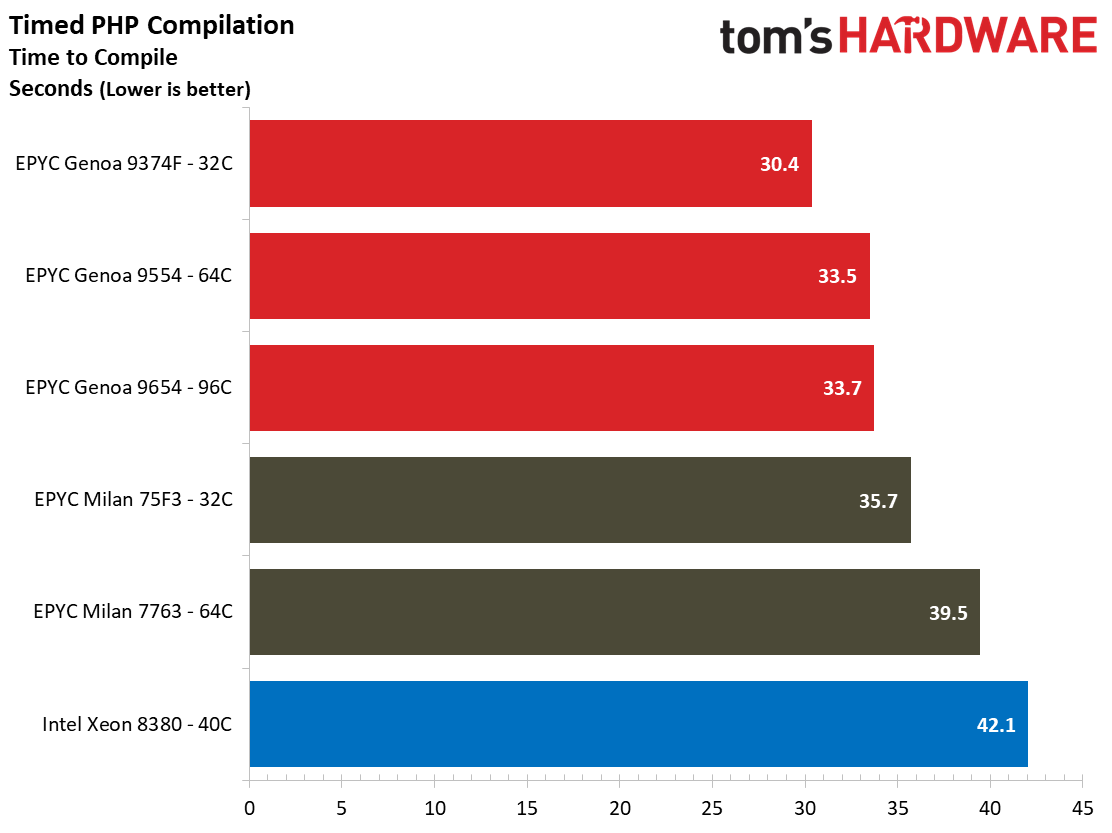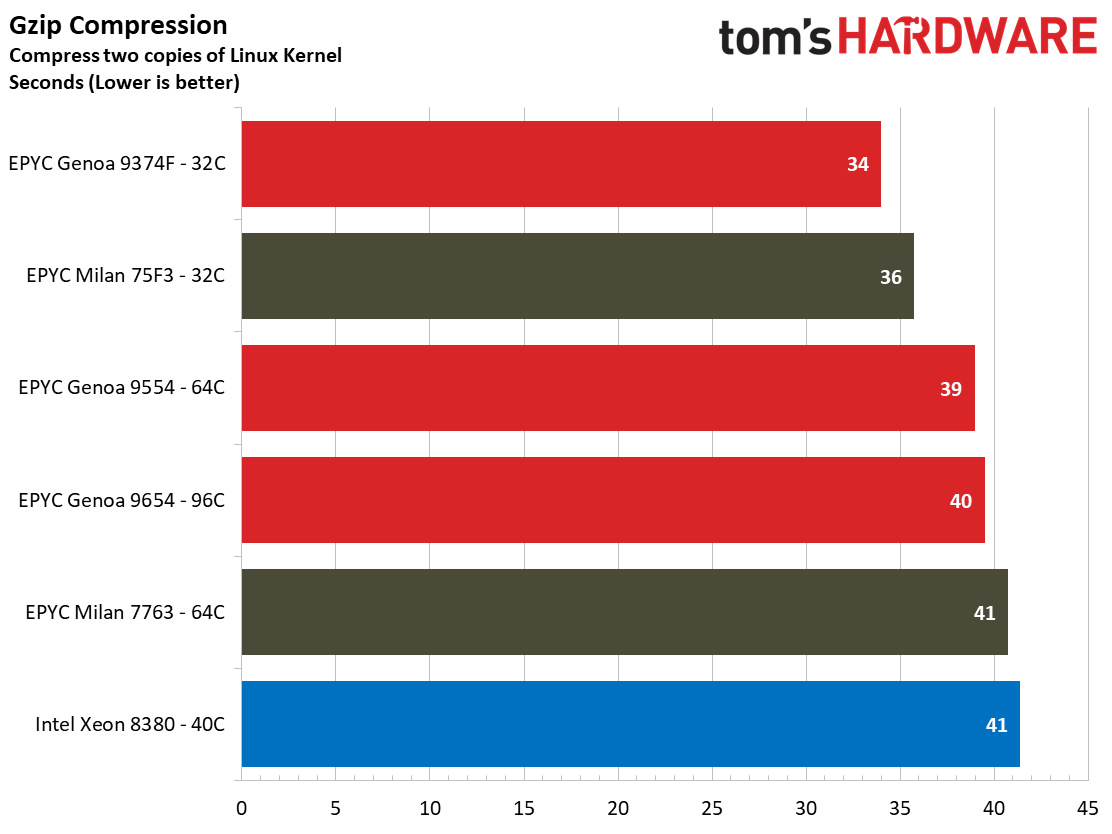Why you can trust Tom's Hardware
All systems are tested in a dual socket (2P) configuration.
| Test Platform | Memory | Tested Processors |
|---|---|---|
| 2P AMD Titanite Reference Platform | 24x 64GB (1.5TB) Samsung ECC DDR5-4800 | AMD EPYC Genoa 9654, 9554, 9374F |
| 2P AMD Daytona Reference Platform | 16x 32GB (512GB) Micron DDR4-3200 | AMD EPYC Milan 7763, 75F3 |
| 2P Intel S2W3SIL4Q Reference Platform | 16x 32GB SK hynix ECC DDR4-3200 | Intel Xeon Platinum 8380 |
| Model | Price | Cores/Threads | Base/Boost (GHz) | TDP | L3 Cache (MB) | cTDP (W) |
|---|---|---|---|---|---|---|
| EPYC Genoa 9654 | $11,805 | 96 / 192 | 2.4 / 3.7 | 360W | 384 | 320-400 |
| EPYC Genoa 9554 | $9,087 | 64 / 128 | 3.1 / 3.75 | 360W | 256 | 320-400 |
| EPYC Milan 7763 | $7,890 | 64 / 128 | 2.45 / 3.5 | 280W | 256 | Row 2 - Cell 6 |
| Xeon Platinum 8380 | $9,359 | 40 / 80 | 2.3 / 3.2 - 3.0 | 270W | 60 | Row 3 - Cell 6 |
| EPYC Genoa 9374F | $4,850 | 32 / 64 | 3.85 / 4.3 | 320W | 256 | 320-400 |
| EPYC Milan 7F53 | $4,860 | 32 / 64 | 2.95 / 4.0 | 280W | 256 | Row 5 - Cell 6 |
Molecular Dynamics and Parallel Compute Benchmarks





NAMD is a parallel molecular dynamics code designed to scale well with additional compute resources; it scales up to 500,000 cores and is one of the premier benchmarks used to quantify performance with simulation code. The 32-Core EPYC 9374F sets the tone for what we'll see throughout many of these benchmarks, as it easily beats the Ice Lake 8380s.
Yes, price tags are largely a mirage in the server world, but it bears mentioning that the 9374F has a suggested $4,850 price tag, while the 8380 is still listed at $9,359 on Intel's site (though we doubt it has sold for that in a long time).
The award-winning Stockfish chess engine is designed for the utmost scalability across core counts — it can scale up to 512 threads (so we still have just a bit of scalability left before Bergamo arrives). Here we can see that this massively parallel code scales well with EPYC's leading core counts as the 96-core EPYC 9654 provides more than twice the amount of performance of the 8380s. Also, note the 64-core EPYC 9554's solid 33% increase over the previous-gen 64-core EPYC 7763. That big jump in performance makes the 15% gen-on-gen price increase for 64 cores feel a lot more palatable.
The Gromacs water benchmark simulates Newtonian equations of motion with hundreds of millions of particles. This workload scales well, but the fact is that many workloads will hit other bottlenecks, like memory throughput or power constraints, before they can fully leverage the 96-cores found on the EPYC 9654. As such, the 64-core EPYC 9554 nearly ties the 9654 in this compute-intensive workload.
We can also say much the same about the LAAMPS molecular dynamics code. While this code is inherently scalable, we're obviously reaching other bottlenecks before the full might of the 9654's cores can be unleashed.
Naturally, the big hyperscalers and tier-one OEMs will make sure that these exotic 96-core chips, which actually don't have exotic pricing given their capabilities, will find a home with workloads that can fully leverage the compute resources.
Get Tom's Hardware's best news and in-depth reviews, straight to your inbox.
Rendering Benchmarks








Turning to the more standard fare, provided you can keep the cores fed with data, most modern rendering applications also take full advantage of the compute resources.
Intel developed Embree, a ray tracing kernel for CPUs that leverages the AVX-512 instruction set, but we don't use the Intel SPMD program compiler (ISPC) to keep things fair. In either case, the EPYC Genoa processors dominate these Intel-designed benchmarks. The 96-core EPYC 9654 provides more than twice the performance of the Intel platform, while the 64-core model provides a nearly linear performance scaling over its 32-core counterpart, the 9374F. That's impressive in its own right.
Moving on to compute-intensive ray tracing benchmarks, the Genoa chips stretch their legs in the Embree-based OSPray benchmark, once again highlighting the incredible imbalance that we'll see in the data center CPU market until Sapphire Rapids arrives.
Linux Kernel, LLVM, PHP, Godot Compilation Benchmarks






Sure, AMD's Genoa is brutal in multi-threaded workloads, so we shifted gears to compilation work to see how the chips handle more varied workloads. Regardless of the compilation tasks we threw at the chips, the Genoa chips provided substantial speedups over the previous-gen Milan chips and beat Intel convincingly. As you can see, frequency comes into play with this type of work, so the Genoa 9374F shows its agility as it chews through the compilation work. It's hard not to like this plucky chip, as it provides an impressive amount of threaded horsepower combined with great performance in frequency-sensitive workloads.
Compression, Security, NumPy and Python Benchmarks








The open-source OpenSSL toolkit uses SSL and TLS protocols to measure RSA 4096-bit performance in verify and sign operations, along with SHA-256 throughput. These heavily multi-threaded workloads are incredibly taxing — we measured up to 1600W of power consumption for the dual-socket Genoa 9654 configuration during these tests — so higher core counts tend to reign supreme if all other factors are equal. They aren't, though, and Genoa's per-core performance advantage powers the 32-core EPYC 9374F to somewhat stunning wins over the 40-core Ice Lake Xeon 8380's. Meanwhile, the 96- and 64-core Genoa models show just how far Intel lags behind the more modern Zen 4 architecture.
The Pybench and Numpy benchmarks are used as a general litmus test of Python performance, and as we can see, these tests typically don't scale linearly with increased core counts, instead prizing per-core performance. Here the 32-core EPYC Genoa 9374F reigns supreme, easily leveraging its superior clock speeds and copious cache to outmaneuver the heftier chips. That said, the 96- and 64-core Genoa models still impress as they outperform Ice Lake by significant margins.
Compression workloads come in many flavors. The 7-Zip (p7zip) benchmark exposes the heights of theoretical compression performance because it runs directly from main memory, allowing both memory throughput and core counts to impact performance heavily. As we can see, this benefits the core-heavy chips as they easily dispatch with the chips with lesser core counts. Intel's Ice Lake demonstrates how badly it already trailed Milan, and Genoa widens the chasm. Even Gzip, which we use to show compression performance with a more frequency-sensitive engine, finds the Xeon Platinum 8380's trailing the entire test pool.
Encoding Benchmarks



Encoders tend to present a different type of challenge: As we can see with the FLAC benchmark, they often don't scale well with increased core counts. Instead, they often benefit from per-core performance and other factors, like cache capacity. Intel's Ice Lake has 60MB of L3 cache, which is woefully inadequate compared to the 256MB and 384MB of L3 etched into the Genoa CCDs for these particular models.
- MORE: Best CPUs for Gaming
- MORE: CPU Benchmark Hierarchy
- MORE: AMD vs Intel
- MORE: Zen 4 Ryzen 7000 All We Know

Paul Alcorn is the Editor-in-Chief for Tom's Hardware US. He also writes news and reviews on CPUs, storage, and enterprise hardware.
-
Roland Of Gilead Okay, for those more knowledgeable than me (I'm not really into server tech), how is it that Intel is so far behind in terms of core count with these systems? Looking at some of the benches (and I might as well be blind in both eyes and using a magnifying glass to scroll through the data!) it seems to me that if Intel were able to increase core count, that they would be comparable in performance to the AMD counterparts? What gives?Reply
Intel have taken the performance crown with ADL and Raptor in the consumer market, but on the bigger scales can't get close. -
rasmusdf Well, basically AMD has mastered the art and technology of connecting lots of small chips together. While Intel still has to make chips as one big lump. Big chips are harder and more expensive to produce. Plus when combining small chips you can always and easily add more.Reply
Intel might be competing right now in the consumer space - but they don't earn much profit on their expensive to produce CPUs.
Additionally - AMD is cheating a bit and is several chip nodes ahead in production process - while Intel is struggling to get past 10 nm, AMD is on what, 4 nm? Because of TSMCs impressive technology leadership and Intels stubborness. -
gdmaclew Strange that Tom's mentions that DDR5 support for these new Data Center CPUs is a "Con" but they don't mention it in yesterday's article of Intel's new CPUs using the same DDR5.Reply
But then maybe not, knowing Tom's. It's just so obvious. -
SunMaster ReplyRoland Of Gilead said:Intel have taken the performance crown with ADL and Raptor in the consumer market, but on the bigger scales can't get close.
Rumour has it that AMD prioritize less on the consumer market, and more on the server marked. So if "one core to rule them all" it means Zen4 is a core designed primarily for server chips. Whether Alder Lake took the "performance crown" or not is at best debateable, as is Raptor Lake vs Zen4 if power consumption is taken into consideration.
Intel does not use anything equivalent of chiplets (yet). The die size of raptor lake 13900 is about 257 square mm. Each Zen4 ccd is only 70 square mm (two in a 7950x). That gives AMD a tremendous advantage in manufacturing and cost.
See oMcsW-myRCU:2View: https://www.youtube.com/watch?v=oMcsW-myRCU&t=2sfor some info/estimates on yields and cost of manufacturing. -
bitbucket You have forgotten the face of your father.Reply
Most likely multiple reasons.
1) Intel struggled for a long time trying to reach the 10nm process
This delayed entire product lines for a couple of years and ultimately led to Intel outsourcing some production to TSMC which wasn't struggling to shrink the fabrication process
2) AMD moved to a chiplet strategy long before Intel, which I don't believe has a product for sale using chiplets yet, not sure though
AMD had already been using TSMC as AMD had sold off their manufacturing facilities years before
Large monolitic, high core-count CPUs are harder to make than smaller lower core-count CPUs
- An example is AMD putting two 8-core chiplets in a package (plus IO die) for a product that has 16 cores
- Intel has recently countered this by going with heterogeneous cores in their CPUs; a mix of bigger/faster and smaller/slower cores
- I don't believe that the heterogeneous core strategy has been implemented in servers products yet -
InvalidError The DIMM slot fragility issue could easily be solved or at least greatly improved by molding DIMM slots in pairs for lateral stability and sturdiness.Reply -
Roland Of Gilead Reply
Fair pointSunMaster said:Whether Alder Lake took the "performance crown" or not is at best debateable, as is Raptor Lake vs Zen4 if power consumption is taken into consideration. -
GustavoVanni It is just me or do you guys also think that AMD can fit 24 CCDs in the same package in the not so distant future?Reply
Sure there's some small SMDs in the way, but it should be doable.
Just imagine one of those with 192 ZEN4 cores ou 256+ ZEN4c cores.
Maybe with ZEN5? -
-Fran- Intel's only bastion seems to be accelerators and burn as much money as they can on adoption, even worse than AVX512.Reply
I just looked at the numbers of OpenSSL and I just laughed... Intel is SO screwed for general purpose machines. Their new stuff was needed in the market last year.
Regards.